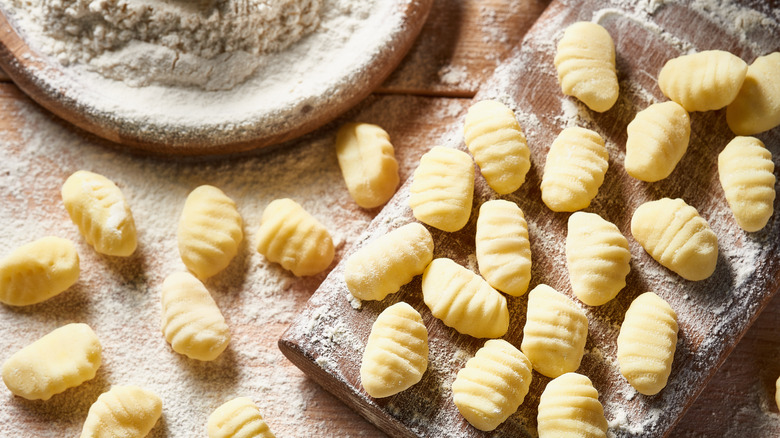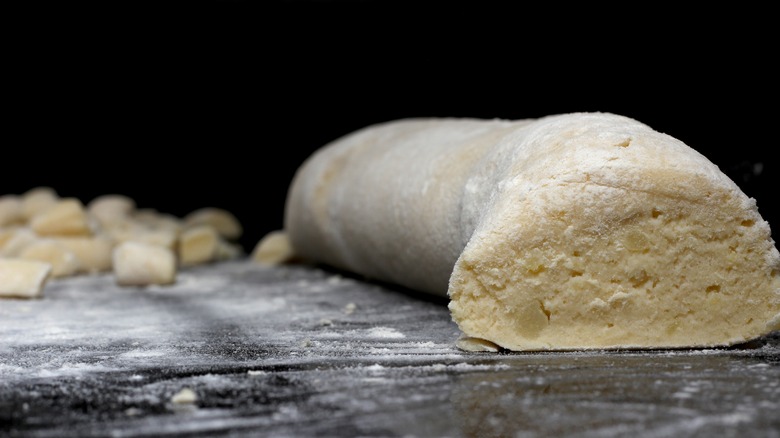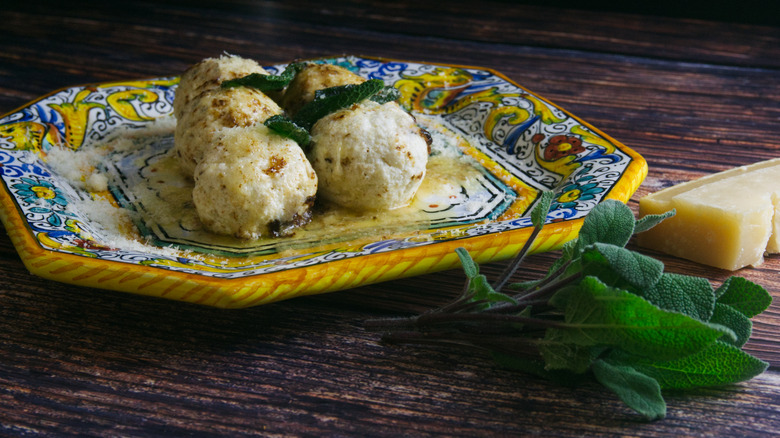Gnudi Vs Gnocchi: What's The Difference?
Dumplings are a dish that can be found all over the world in different forms. From halusky dumplings to gyoza and knedlíky, you can find a country's variation of dumplings wherever you go. Arguably, one of Italy's most famous versions of this is gnocchi. Whether you've been to Italy or not, there is a significant chance you've encountered gnocchi before. Potato gnocchi, in particular, has gained international popularity, most commonly found alongside other pasta menu items, usually featuring any variety of house-made sauces from pesto to mushroom and a classic tomato sauce. But a lesser-known Italian dumpling, gnudi is gnocchi's Tuscan cousin.
Gnudi is different because it replaces the potato in gnocchi with ricotta cheese or ricotta and spinach. It is similar to the filling that goes into spinach ravioli but without the outer pasta layer. The name gnudi, which means 'naked' in Italian, resembles a ravioli without the pasta. Gnudi is served in rounded dumpling shapes, slightly larger than gnocchi. Although gnocchi and gnudi might outwardly look similar, don't be mistaken by appearances. Everything from their texture and preparation to their place of origin is different. Actually, being Italian dumplings might be one of the only similarities that gnocchi and gnudi share.
The biggest difference is in the ingredients
While both dumpling recipes may use eggs and flour, the preparation and remaining ingredients vary greatly. Homemade gnocchi consists of potatoes and flour as its main ingredients, giving it a light but reasonably firm texture. Gnudi, on the other hand, is creamy and fluffy when made right, thanks to the combination of ricotta and parmesan, along with the minimal amount of flour. A typical gnudi recipe can contain as little as ¼ cup of flour for every 1 pound of ricotta, while gnocchi recipes contain around 1 cup of flour for every 1 pound of potatoes.
How gnocchi and gnudi doughs are handled is also partly responsible for the difference between the two dumplings. Part of the gnocchi preparation involves lightly kneading until the mixture forms a soft dough, which allows the gluten to form and gives gnocchi its firm texture. A typical gnudi recipe only requires mixing the ingredients, which gives this Tuscan dumpling counterpart a softer and fluffier bite.
Gnocchi and gnudi come from different regions
Although gnocchi dates back to Roman times, the most commonly known potato gnocchi made a later appearance around the 16th century, when potatoes showed up in Italian cooking. Potato gnocchi is said to have originated in northern Italy, where potatoes thrived in cooler climates. It is said that the Tuscans created gnudi to make use of the abundance of spinach and ricotta available in the region. Gnocchi and gnudi do share one historical similarity, though. Much like Italian pasta and pizza, both of these dumplings started as dishes for the impoverished, making use of ingredients that were readily available.
The way that these two dumplings are served also varies. Gnudi is traditionally served with brown butter and sage so that the natural flavor of these ricotta dumplings isn't overpowered. The most traditional serving sauces for gnocchi are typically more robust in flavor, like an Italian tomato sauce. Because gnudi is so delicate, it is usually plated first, with the sauce spooned over the top. Conversely, gnocchi is typically tossed into the sauce before being served.


